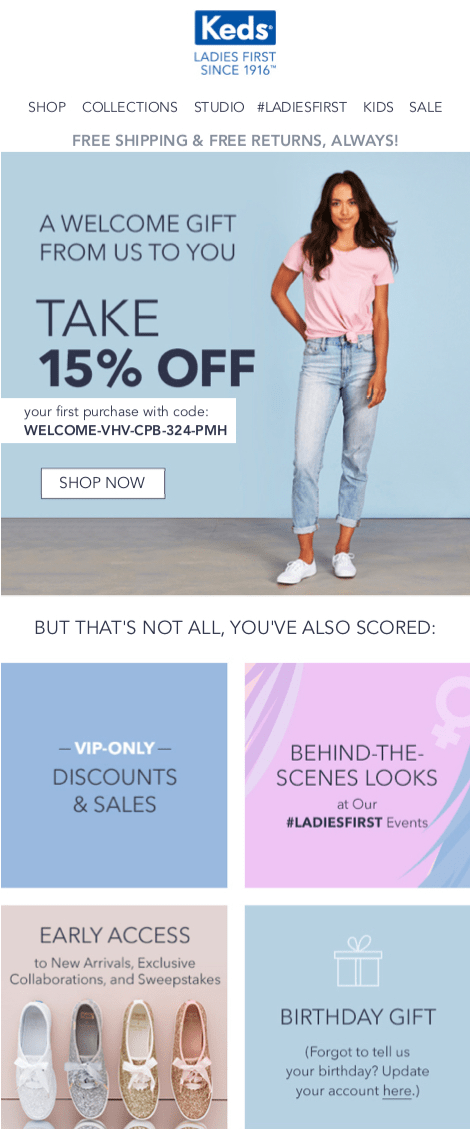
4 Email Marketing Campaigns Ecommerce Brands Can Automate Today

Email, email, email—these days, a channel once reserved for work memos and evites has solidified its reputation as an indispensable business marketing tool. It’s no surprise we’ve talked about why every CPG brand needs an email list, but how you engage that list is just as important as building it.
For brands with an ecommerce focus, email marketing automation can effectively transform the way you do business and communicate with your customers. And it starts with knowing which emails to automate in your business for maximum impact. Here are four ways to get started with email automation today.
Welcome Email
When to send: Immediately after signup
There are few opportunities to engage email subscribers as powerful as immediately after they join your list. Think about it—they have just chosen to subscribe to receive your emails. Your brand is fresh in their minds, and something about it led them to type their email in your signup form. This is your chance to make a lasting, positive first impression. Moreover, 74% of consumers expect a welcome email to hit their inbox as soon as they subscribe to a new list.
An effective welcome email (or series) should accomplish two goals—confirm a new subscription and offer that new subscriber value right away. When drafting that first point of contact, consider including:
- A welcome offer – shoppers often subscribe to newsletters in exchange for a percentage off a purchase they already intend to make. Keds’ welcome email includes a unique code that not only gives shoppers 15% off but makes for efficient tracking of the campaign’s success.
- Subscriber exclusives – from sneak peeks at new collections to early sales access, let your subscribers know you’re thinking of them.
- A preview of content to come – how often will subscribers hear from you? What kinds of offers, information or other content will they receive?
- Ways to engage with your brand – invite new subscribers to follow and interact with you on your social channels, blog or other content platforms.
Abandoned Cart Reminders
When to send: Starting 24 hours after an item is placed in cart
We live in a 22-tab society. That means your online customers are browsing your site, catching up on email, planning their next trip and more—all at once. It also means they may forget about items they’ve added to their cart or get distracted by the latest cat video before they complete their purchase.
Enter abandoned cart emails—one of the hardest working tools in any ecommerce email marketing strategy.
Automating an abandoned cart email helps keep your brand and products top of mind with customers who have already shown an interest in what you have to sell. And you don’t need to stop at one email. Follow up emails can be triggered 24, 48 or 72 hours following a guest’s cart activity, with each email offering strong, value-focused encouragement to complete checkout.
Take Four Sigmatic’s approach to reeling customers back in for example. The mushroom and superfood beverage company offers shoppers $5 off their order to complete their purchase within the following 48 hours and makes checking out as easy as clicking a big red button.
Shipping and Order Confirmation Emails
When to send: Immediately following new order
We’ve all heard the phrase “strike while the iron’s hot.” In ecommerce, that iron reaches peak temperatures immediately following a new order. A customer has placed an order through your website and, more often than not, will turn to their email to ensure they receive a prompt confirmation.
Automated order confirmation emails and receipts should be part of your ecommerce marketing strategy from day one. But, there are ways to make these transactional emails part of your conversion tactics. Ecommerce giant Amazon signs off their shipment confirmations with links to recommended products based on your purchase history, as well as an Alexa prompt to track your package’s journey.
Take your order or shipping confirmation emails to the next level by including product suggestions, offers or discounts for future shopping, instructions on how to use or get the most of the item purchased, or highlight more of your brand’s story.
We Miss You Emails

Despite marketers’ best efforts, email engagement rates may drop over time. Your brand’s messages may have lost their “shiny penny” effect or gotten buried in subscribers’ inboxes (the average person receives upwards of 100 emails every day). Subscribers stop opening emails, and even when they do, they aren’t likely to engage with your content. However, an unengaged subscriber is still a subscriber and potential customer. And we all know the old business adage—it is easier (and cheaper) to keep a current customer than to go out and find a new one. That’s exactly what re-engagement emails aim to do.
Re-engagement emails, win-back emails, “We Miss You” emails—though these emails go by many names, their results are undeniable. Forty-five percent of those who read a re-engagement email will read future emails. Sent to subscribers who haven’t opened or clicked on an email in a specified period of time, re-engagement emails may include a special offer designed to encourage a new order or engagement with your brand across social media.
You could even ask a subscriber that hasn’t interacted with your content in a while how you can better serve them. Do they find value in your emails? If not, make it easy for them to unsubscribe from your list. This may sound counter-productive, but today’s consumers appreciate honesty in brands. Being willing to lose a subscriber if your emails are not aligned to that person’s values can up your brand’s authenticity factor and work in your favor.
Effective, results-driving email marketing blends timeliness with value, reaching subscribers at key moments with strong offers. When implemented strategically, email automation has simplified and streamlined ways to strike that balance.



